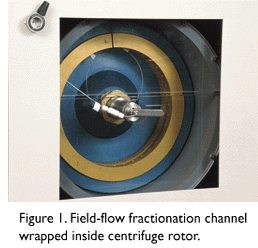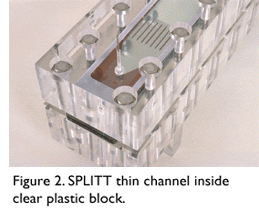 This page has been mothballed.
This page has been mothballed.
It is no longer being updated but we've left it here for reference.
Role of Colloids in the Environement

- Collaborators
- Water Studies Centre, Monash University, Australia
- Macaulay Contact
 Colloids are microscopic particles
with sizes in the range 1 to 0.01 µm. Because of their small size they
tend not to settle out of suspensions, being influenced by Brownian motion and
minor currents in the bulk of the solution. Colloids play an important role in
the transfer of nutrients and pollutants in the environment over short and long
distances. For example, colloids can transport nutrients such as phosphate
through channels in soil to deeper horizons, as well as over much longer
distances in surface waters. For chemical species strongly bound to soil,
colloids can be the main vehicle for their transport. A knowledge of the
physical and chemical composition of environmental colloids involved in
nutrient and pollutant transport is important if the relevant processes are to
be understood and accurately modelled.
Colloids are microscopic particles
with sizes in the range 1 to 0.01 µm. Because of their small size they
tend not to settle out of suspensions, being influenced by Brownian motion and
minor currents in the bulk of the solution. Colloids play an important role in
the transfer of nutrients and pollutants in the environment over short and long
distances. For example, colloids can transport nutrients such as phosphate
through channels in soil to deeper horizons, as well as over much longer
distances in surface waters. For chemical species strongly bound to soil,
colloids can be the main vehicle for their transport. A knowledge of the
physical and chemical composition of environmental colloids involved in
nutrient and pollutant transport is important if the relevant processes are to
be understood and accurately modelled.
Field-flow fractionation represents a family of techniques for the separation of particles, colloids and large molecules depending on a specific property. Sedimentation field-flow fractionation (sed-FFF) methods offers a means to fractionate colloids, with high resolution. In the normal mode of operation, separations are based on the buoyant mass and diffusion coefficients of the colloids, and on the differential parabolic flow of liquid in the thin channel of the sed-FFF separator (Figure 1). Monash University is a lead centre for such work, being equipped with state-of-the-art FFF devices and detectors such as a high resolution, inductively coupled, mass spectrometer (HR-ICP-MS). With a suitable interface the eluent from FFF devices can be analysed on-line by HR-ICP-MS, providing continuous information about elemental composition of colloids and their corresponding size/mass. Other variants of the FFF method include those based on charge (electrical-FFF), particle size (flow-FFF) and thermal diffusion (thermal-FFF).
To gain knowledge of the FFF methods and other procedures related to the
characterisation of colloids, a 3-month visit, funded by the Institute and The
Royal Society, was made to work with Dr R. Beckett and his group at the Water
Studies Centre of Monash University in Melbourne, Australia. Experimental
parameters were developed to allow sed-FFF separations of colloids derived from
soils in Scotland. These soils had received sewage sludge contaminated with
various heavy metals some years before and it was of interest to determine the
distribution and availability of the heavy metals in different sized colloidal
fractions. The size distribution of particles were determined by sed-FF F and a preliminary study was made of the elemental
composition of the samples by graphite furnace atomic absorption spectroscopy
on samples digested with aqua regia. This paved the way for experiments where
the FFF device was connected on-line to the HR-ICP-MS. Samples of the colloids,
before and after extraction with solutions such as dilute acetic acid (which is
often used to determine metal bioavailability in acid soils) were analysed
on-line and the distribution of elements determined and related to particle
sizes. This work was carried out in collaboration with a research student.
Although the amount of sample which can be loaded onto the FFF channel is
small, discrete fractions of colloids eluting from sedimention-FFF can be dried
and analysed by electron microscopy to determine their shape and by X-ray
diffraction to determine mineralogy.
F and a preliminary study was made of the elemental
composition of the samples by graphite furnace atomic absorption spectroscopy
on samples digested with aqua regia. This paved the way for experiments where
the FFF device was connected on-line to the HR-ICP-MS. Samples of the colloids,
before and after extraction with solutions such as dilute acetic acid (which is
often used to determine metal bioavailability in acid soils) were analysed
on-line and the distribution of elements determined and related to particle
sizes. This work was carried out in collaboration with a research student.
Although the amount of sample which can be loaded onto the FFF channel is
small, discrete fractions of colloids eluting from sedimention-FFF can be dried
and analysed by electron microscopy to determine their shape and by X-ray
diffraction to determine mineralogy.
SPLITT is a separation technique closely related to sed-FFF and allows "splitting" of particles in suspension into groups of sizes (typical range 25 to 2 µm) on a continuous basis using a flat, thin channel (Figure 2) and differential migration under gravitational force. The technique has application for preliminary separation of particles for sed-FFF.
The Macaulay is equipped with sed-FFF and SPLITT devices.

